AGILE Top Results
| Date | |
|---|
Feb 14, 2024
 |
The AGILE satellite re-entered the atmosphere
After 17 years of thriving operations, the AGILE Italian scientific satellite re-entered the atmosphere, thus ending its intense activity as a hunter of some of the most energetic cosmic sources in the Universe that emit gamma and X-rays.
AGILE, built by ASI with contributions from INAF and INFN, Italian universities and industry, has been a unique and hugely successful space program in the landscape of Italian space activities. Observations acquired by the satellite were received on the ground by ASI's Luigi Broglio Space Center station in Malindi, Kenya. The data were then sent to the Telespazio Control Center through the ASINet operational network, and then to the ASI Space Science Data Center in Rome, which is responsible for all scientific operations: from management, analysis and archiving to distribution of the data and related catalogs accessible to the international community.
AGILE's scientific output consists of more than 800 bibliographic references, including more than 160 refereed articles and 12 mission catalogs published through January 2024 (also available as interactive SSDC webpages here).
AGILE's major scientific discoveries include: the first detection of galactic cosmic ray sources in Supernovae remnants, evidence of extremely rapid particle acceleration from the Crab Nebula with a rapidly rotating pulsar at its center (Bruno Rossi Prize 2012), and the detection of transient gamma-ray emission associated with relativistic jet emission from the galactic black hole binary system Cygnus X-3.
During its operational life, AGILE has also revealed many transient events of cosmic origin such as Gamma Ray Bursts (GRBs), searched for high-energy emission associated to neutrino events and Fast Radio Bursts (FRBs), detected thousands of solar flares, as well as events of terrestrial origin such as Terrestrial Gamma-ray Flashes (TGFs). AGILE has contributed with a leading role in the search for possible counterparts of gravitational wave (GW) sources, and AGILE's follow-up observations have provided the fastest response and most significant upper limits above 100 MeV on all GW events detected by the Ligo-Virgo-Kagra collaboration to date.
With the AGILE's re-entry, the in-orbit operational phase comes to a close, but a new phase of scientific work on the satellite legacy data archive opens: AGILE may still hold future surprises.
Additional links:
COMUNICATO STAMPA CONGIUNTO ASI-INAF-INFN (in italian): ASI news, INAF news 
|
Jun 9, 2023
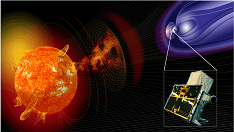 |
Latest news from the AGILE Data Center
The AGILE satellite of ASI is devoted to gamma-ray astrophysics, orbiting the Earth in a near equatorial orbit since April 23, 2007. After more than 16 years of operations, AGILE is working nominally, providing valuable data and important scientific results. The instrument is capable of detecting gamma-ray transients and GRB-like phenomena on timescales ranging from sub-milliseconds to tens-hundreds of seconds.
The fast AGILE data acquisition system and trigger configuration is optimized for the search of gamma-ray counterparts of gravitational waves (GW) and other transients, such as GRBs, TGFs, neutrinos and Fast Radio Bursts (FRB).
Hereafters are some of the main recent news from AGILE:
- AGILE GW follow-up
AGILE is actively involved in the hunt for high-energy electromagnetic counterparts of GW during the current LIGO-Virgo-Kagra (LVK) O4 observing run, started on May 24, 2023. Indeed, the first 2023 GW event (S230518h) was published on May 18, 2023, prior to the official start of O4, during the last days of the so-called engineering run of the LIGO detectors.
The LVK GW event S230518h has been identified as a significant GW compact binary merger candidate with high probability (86%) to be composed by a Neutron Star-Black Hole (NSBH) merger, which has a higher probability to have an electromagnetic counterpart.
AGILE results from the fast follow-up of GW S230518h were published in the GCN Circular #33826, reporting the AGILE/MCAL flux upper limits in the 0.4 - 1 MeV energy range, for 1 s integration time from the GW trigger time (T0), at different celestial positions within the accessible Localization Region (LR). The detection of a short pulse in the same energy band with S/N ~ 5.7 at T0+10.77 s was also reported by AGILE.
- New AGILE Public Data now available up to March 31, 2023
We are pleased to announce the publication of new AGILE gamma-ray data up to March 31, 2023. The new public AGILE archive now contains all data from December 1, 2007 up to March 31, 2023, i.e. from Observation Block (OB) 4900, start of Cycle-1 up to OB 41200 of the on-going Cycle-16. AGILE-GRID event files (EVT) and spacecraft auxiliary (LOG) files are available from the SSDC Multimission Archive (MMIA) webpage for the AGILE Mission.
Since October 2015 all AGILE-GRID data are published as soon as they are processed and validated. To produce your own maps and run likelihood tasks please download and install the public AGILE software AGILE_SW_6.0 available here, and follow the User Manual included.
An open-source Python package named Agilepy, built on top of the command-line version of the AGILE/GRID Science Tools, has been developed at INAF/OAS Bologna to analyse AGILE/GRID data. Since version 1.5.0, Agilepy has implemented an automated download of public AGILE GRID data using an SSDC REST Api.
For an easy on-line AGILE data analysis, the interested user may also query the entire public AGILE level 3 (LV3) archive through the AGILE-LV3 data analysis tool.The AGILE-LV3 tool is meant to be easily comprehensible, and it does not require any install-on-premises software or calibrations.
- The First AGILE Catalog of Solar Flares: more than 15 years of observations
We are pleased to announce that the first AGILE catalog of solar flares detected by the on-board Anti-Coincidence system in the 80-200 keV energy range in more than 15 years of observations has been accepted for publication in The Astrophysical Journal Supplement:
"The First AGILE Solar Flare Catalog" (A. Ursi et al. 2023), to appear in ApJS.
While awaiting publication inthe ApJS journal, the article is accessible on arXiv:2305.14957
It is a catalog of more than 5000 events all cross-related with the official GOES, with RHESSI and Fermi GBM. Of these there are more than 1400 new "AGILE only" events constituting a new dataset of solar flares detected in the hard X-ray energy band.
Furthermore, an on-line version of the AGILE solar flare catalog is also available as an interactive web page at SSDC, providing access to additional data products (light curves of the solar flares, both in image format and in text format).
Additional links:
ASI news (in italian)
INAF news (in Italian)
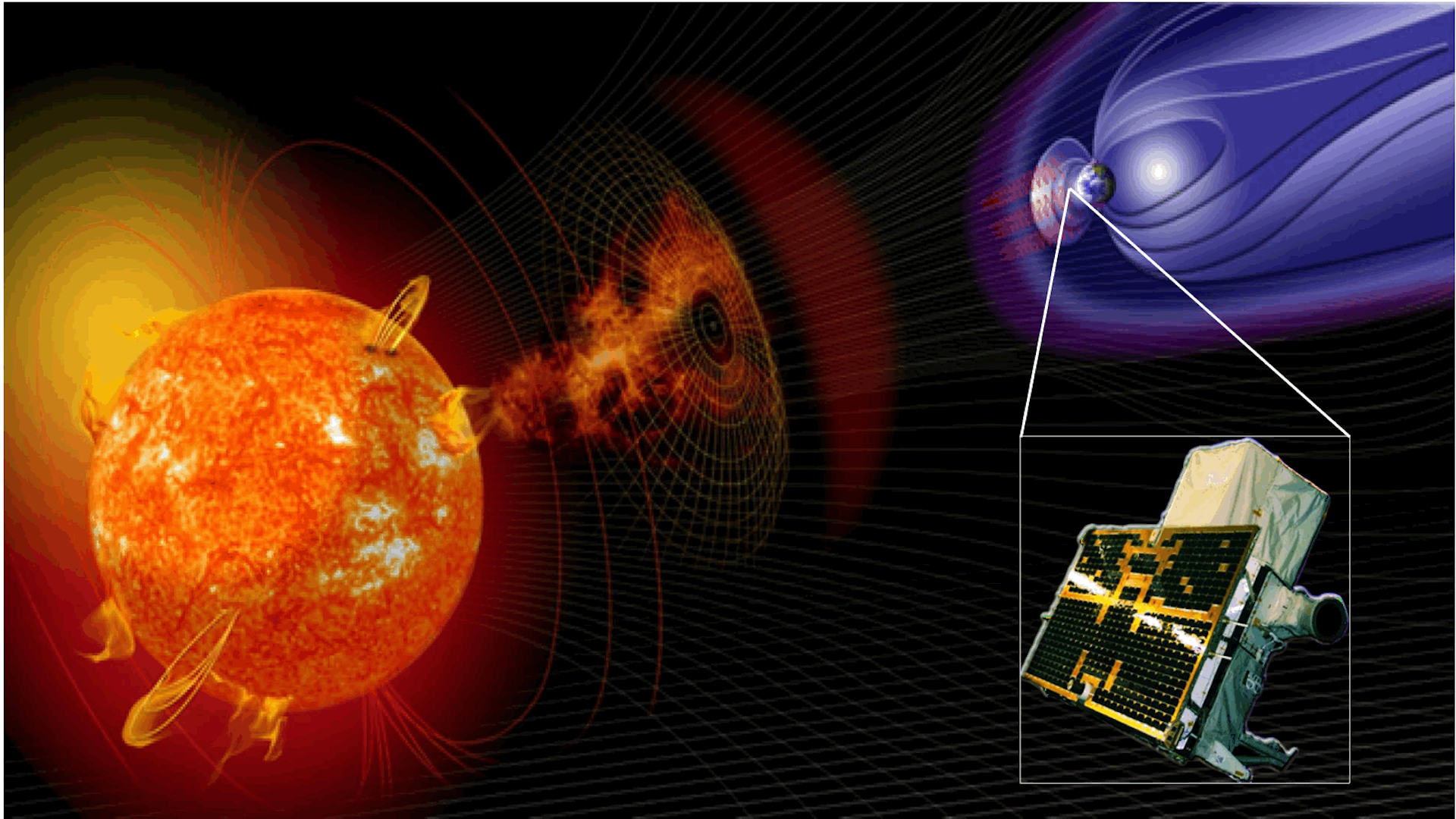
Artistic rendition of the AGILE satellite orbiting the Earth (credit ASI).
|
Apr 22, 2022
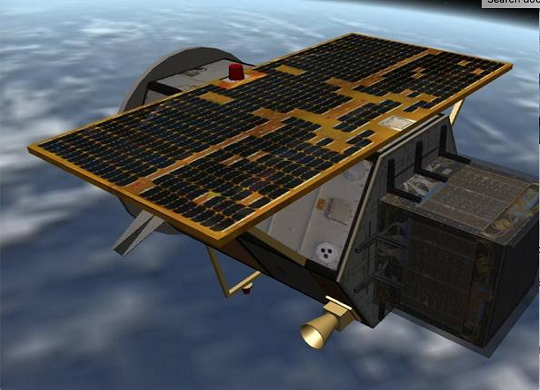 |
The ASI scientific satellite AGILE turns 15 years in orbit
15 years after its launch on 23 April 2007, the AGILE satellite of ASI, built and operated in cooperation with INAF and INFN, is still fully operational and continues its monitoring of the high-energy sky. AGILE is providing a unique contribution to the search for the gamma-ray counterparts of gravitational waves, neutrinos, fast radio bursts and other transients.
In these fifteen years, the satellite has completed more than 77,600 orbits around the Earth equator. AGILE observations are regularly transmitted to the ground through the ASI tracking station in Malindi (Kenya), sent to the Telespazio control center in Fucino via ASINET, and from there to the ASI Space Science Data Center (SSDC) in Rome, which oversees all the scientific activities related to the analysis, archiving and distribution of AGILE data.
AGILE made several important scientific discoveries, including: a novel mechanism of particle acceleration operating in the Crab Nebula (Bruno Rossi Prize 2012); the emission of transient gamma-rays correlated with relativistic jet ejections from Galactic compact sources; the first evidence of hadronic cosmic ray production from a SNR; the emission of very powerful gamma-ray flares from accreting super-massive black holes in AGNs. Also, terrestrial applications are relevant for the science program: AGILE discovered gamma-ray emission above 20 MeV from Terrestrial gamma-ray flashes (TGFs) produced by powerful lightning and thunderstorms.
Recently, AGILE observations in April 2020 provided crucial information relevant to our understanding of the physical mechanisms behind the mysterious fast radio bursts (FRBs) and their connection to magnetar events.
Finally, thanks to a new dedicated pipeline detecting variations of the count rate from the Anticoincidence panel oriented toward the Sun, AGILE may play a role also in solar related science, providing a fast alert to the space weather community about hard-X ray flares (80-200 keV) observed from the Sun.
- Links (in Italian): ASI News; Media INAF News
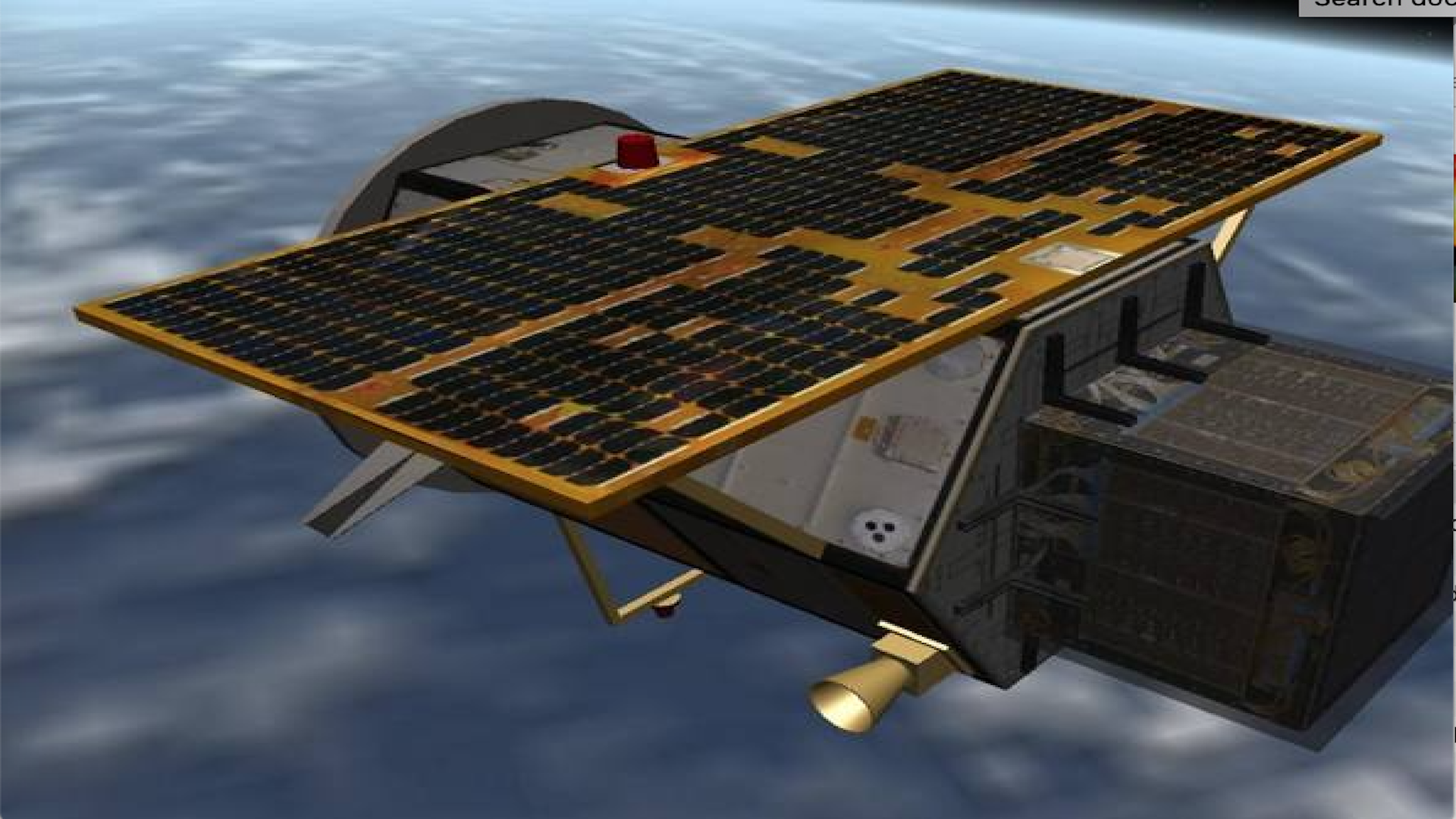
Artistic rendition of the AGILE satellite orbiting the Earth (credit ASI).
|
Aug 10, 2020
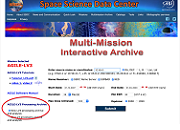 |
Updated AGILE-LV3 tool for on-line gamma-ray data analysis and reprocessed AGILE data archive
A new version of the AGILE-LV3 Tool with updated underlying software and calibrations(*) is now publicly available. In particular, the following improvements have been made:
- new underlying Level-3 reprocessed data archive of all AGILE data, from December 1, 2007 up to March 31, 2020;
- updated scientific software and calibrations for on-line data analysis;
- updated AGILE diffuse background model in the Galactic Center region;
- updated list of known AGILE sources to be queried within the ROI, based on the Second AGILE Catalog 2AGL, including extended sources.
The AGILE-LV3 Tool is meant to be easily comprehensible, and it does not require any install-on-premises software or calibrations.
(*) AGILE SW package AGILE_SW_6.0_SourceCode adapted from AGILE Science Tools BUILD25 and IRF H0025
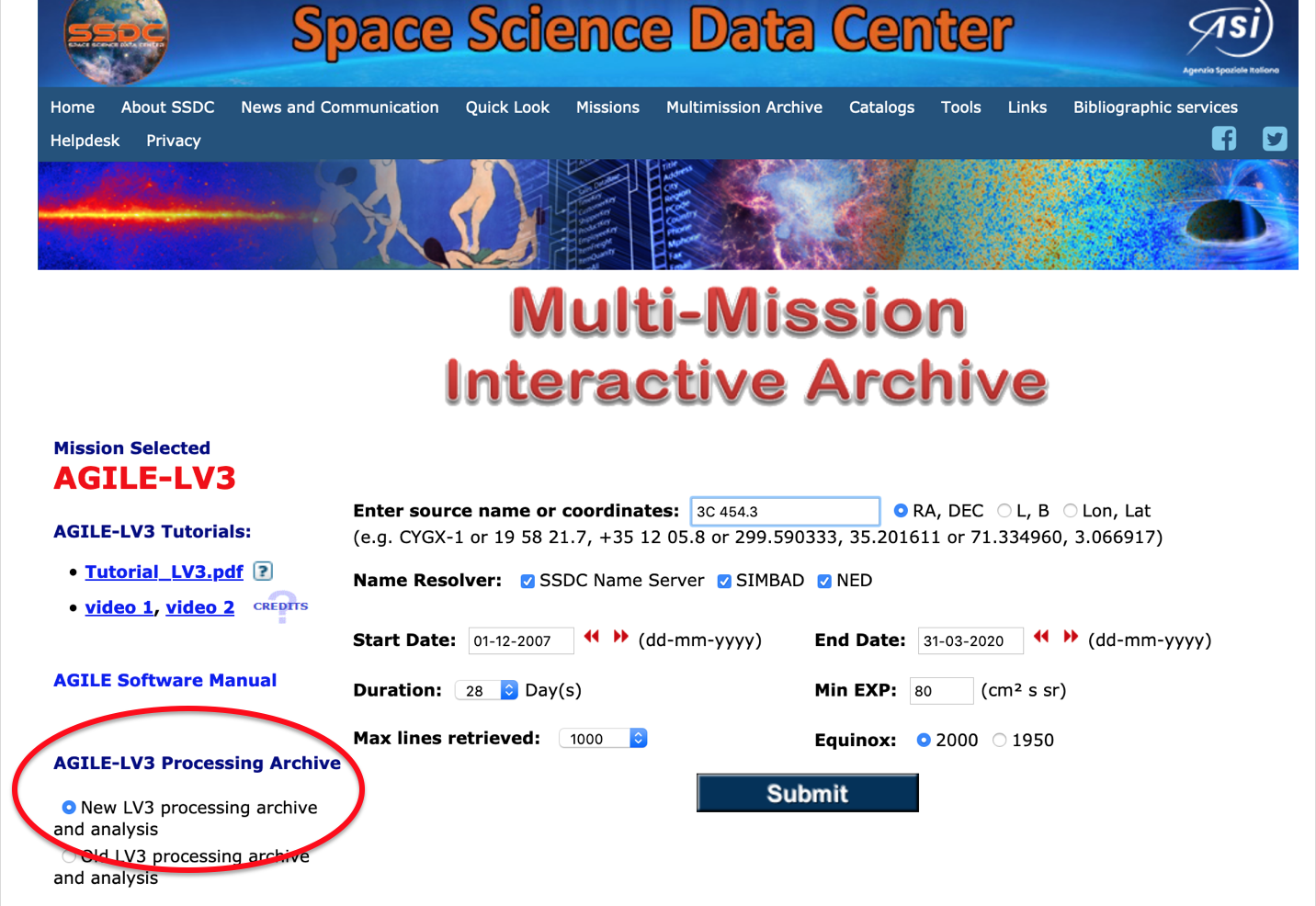
|
Nov 20, 2019
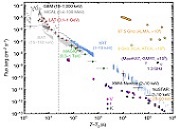 |
TeV emission from a GRB detected by MAGIC for the first time in history: GRB190114C and the extensive campaign of multi-wavelength observations
On 14 January 2019, the Major Atmospheric Gamma Imaging Cherenkov (MAGIC) telescopes observed and detected radiation up to at least 1 teraelectronvolt (TeV) from the Gamma Ray Burst (GRB) named GRB190114C, following an alert from the Neil Gehrels Swift Observatory and the Fermi satellite.
The prompt event emission was also independently detected by AGILE (with MCAL and SuperAGILE), KONUS-Wind, INTEGRAL-SPIACS and Insight-HXMT.
This is the first GRB ever reported by ground-based Cherenkov telescopes, and the MAGIC announcement triggered an extensive campaign of follow-up observations at all wavelengths, from radio to TeV. Emission up to TeV energies from GRBs had been foreseen in some theoretical studies, but it had remained until now unobserved. The detection of TeV radiation opens a new window in the electromagnetic spectrum for the study of GRBs.
The ASI Space Science Data Center (SSDC) has been involved in this unprecedented result published today on Nature:
"Observation of inverse Compton emission from a long gamma-ray burst", MAGIC Collaboration et al., Nature, vol. 575, p. 459-463 (2019)
Nine (INAF and ASI) SSDC researchers are among the authors of the Nature paper published today (in alphabetical order):
- Angelo Antonelli (MAGIC)
- Ciro Bigongiari (MAGIC)
- Valerio D'Elia (MAGIC & Swift)
- Alessandra Lamastra (MAGIC)
- Saverio Lombardi (MAGIC)
- Fabrizio Lucarelli (AGILE)
- Matteo Perri (Swift)
- Carlotta Pittori (AGILE)
- Francesco Verrecchia (AGILE)
For more information, see also:
- Papers:
- Links (in Italian):
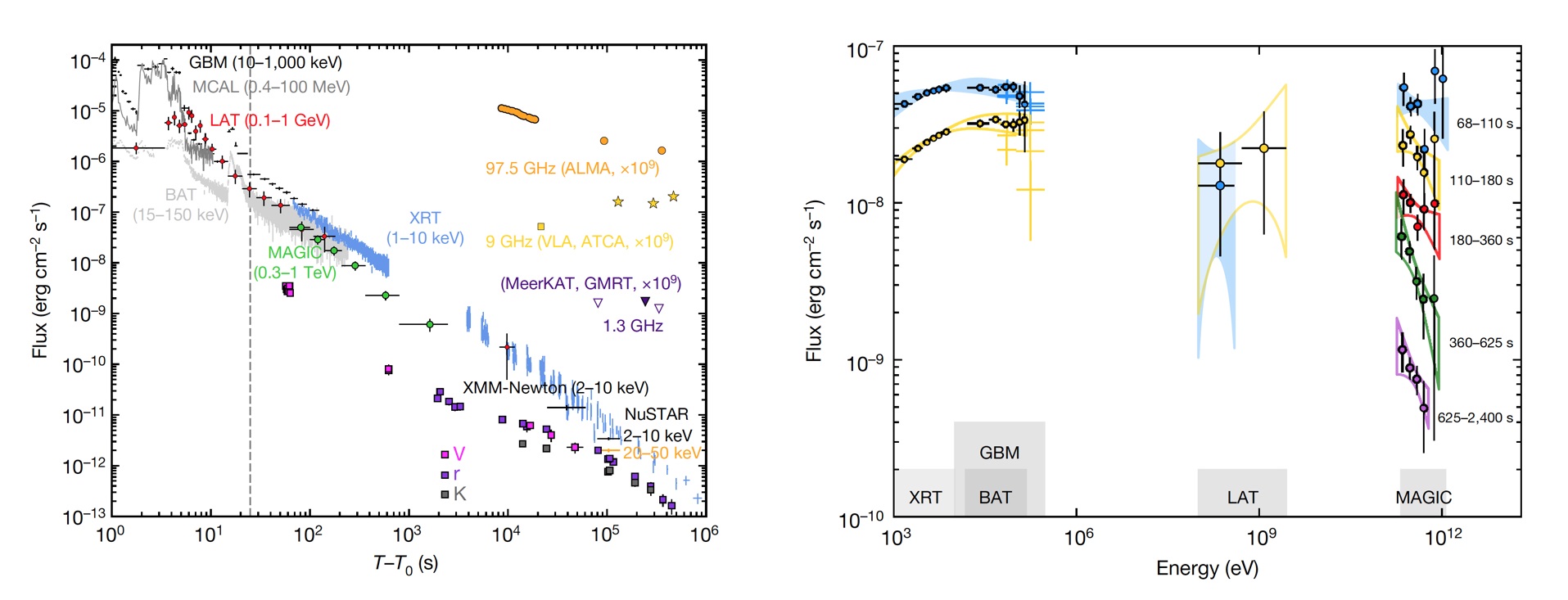
Figure: multi-wavelength light curves (left panel) and multi-band spectra (right panel) of GRB 190114C. Credits: Adapted from the MAGIC Collaboration et al., Nature paper: "Observation of inverse Compton emission from a long γ-ray burst".
|
Jul 12, 2018
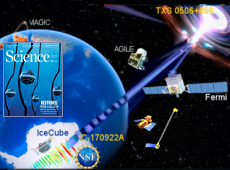 |
Discovery of neutrino and gamma rays from the same blazar source by IceCube and Fermi with contribution of MAGIC and AGILE
Neutrinos, electrically uncharged and traveling at nearly the speed of light, are able to escape the densest astrophysical environments and point back to their source of origin, therefore they represent unique tracers of cosmic-ray particles acceleration. Such extreme environments can be found in blazars, that are active galactic nuclei characterized by accreting supermassive black holes developing immense relativistic jets of plasma pointing close to our line of sight. Blazars are among the most powerful objects in the universe speculated to be sources of high-energy cosmic rays. The discovery of an association of a very high-energy neutrino with a flaring photon gamma-ray blazar object by the IceCube experiment and the Fermi space satellite, announced on July 12, 2018 with a press conference by NSF and a cover and paper in the Science journal, highlights for the first time mechanisms and conditions for highest-energy cosmic rays acceleration and the existence of extragalactic sources producing high-energy neutrinos and gamma rays. The detection of an about 290 TeV energy neutrino (namely the event IC-170922A) on 22 September 2017 by the IceCube experiment at the Amundsen-Scott South Pole Station, in Antarctica, was found to be consistent with the location of a Fermi Gamma-ray Space Telescope catalogued gamma-ray source (3FGL J0509.4+0541, i.e. the blazar TXS 0506+056). The Fermi Large Area Telescope (LAT) first reported the positional coincidence (within 0.1 degrees) of the very high-energy neutrino event with a gamma-ray source detected at E>100 MeV, the blazar TXS 0506+056 (also known as MG1 J050927+0541, RX J0509.3+054, ZS 0506+056 and other), in a flaring state, issuing one Astronomer's Telegram (ATel) on September, 28, 2017. This triggered many observations and results with the corresponding multi-wavelength follow-up measurements, for example by MAGIC, AGILE, Swift and NuSTAR. All these are missions and experiments see the participation of the ASI Space Science Data Center (SSDC), and Fermi, MAGIC and AGILE are built with a fundamental contribution of INFN and INAF. Notably AGILE confirmed soon after the association of IC-170922A with the E>100 MeV gamma-ray activity of TXS 0506+056 with another ATel, while the MAGIC Cherenkov telescope also detected it and revealed periods where the gamma-ray flux from the blazar reached energies of up to 400 GeV. Subsequent measurements of the source have been completed at X-ray, optical, and radio wavelengths. Formerly AGILE suggested also a possible association of gamma rays with an IceCube neutrino event in July 2016, after the detection of a gamma-ray transient found to be consistent with the position and time of IC-160731. Based on the redshift of TXS 0506+056, with value z=0.3365 corresponding to a luminosity distance of 5.5 billion light years, accurately measured and published in February 2018 (only upper/lower limits were available before), constraints are derived for the muon neutrino luminosity for this source, found to be similar to the luminosity observed in gamma rays. The energies of the gamma rays and the neutrino indicate that blazar jets may accelerate cosmic rays to at least several PeV. Chance correlation of this neutrino with the flare of TXS 0506+056 is statistically disfavored at the level of 3 sigma in any of the evaluated models associating neutrino and gamma-ray production. This important result for the newborn multi-messenger astro-particle physics confirms the close relations among the different cosmic messengers. The most extreme cosmic explosions producing transient gamma rays (GRBs) also produce gravitational waves, and the most extreme cosmic accelerators producing intense, persisting and variable flux of gamma-rays (blazars) produce high-energy neutrinos and cosmic rays. Through the Fermi and AGILE satellites and the large ground based astro-particle experiments for neutrinos, UHE cosmic rays and gravitational waves, gamma rays are providing a bridge to each of these new cosmic signals, opening the multi-messenger astronomy era. Many interpretations and works, published or in preparation, are following up the discovery, shedding light on a truly multi-messenger scenario for the flaring GeV gamma-ray blazar TXS 0506+056 and the implications for very high-energy neutrino emission and cosmic ray acceleration. The ASI SSDC is contributing and supporting archive, data, software and science operations and data analysis tasks for the Fermi, AGILE, Swift, and NuSTAR missions. More information: Italian news: 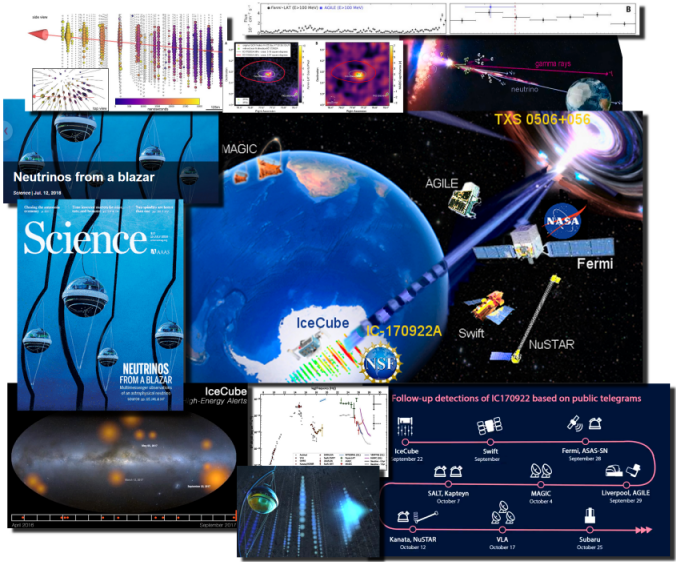 Figure collage credits: SCIENCE magazine/American Association for the Advancement of Science (AAAS), SCIENCE Communication Lab, IceCube Collaboration, NSF U.S. National Science Foundation-Office of Polar Programs, NSF U.S. National Science Foundation-Physics Division, University of Wisconsin-Madison, National Aeronautics and Space Administration (NASA), NASA's Goddard Space Flight Center/CI Lab, NASA/DOE/Fermi Large Area Telescope Collaboration, Sonoma State University, MAGIC Collaboration, AGILE Collaboration, PGC/NASA U.S. Geological Survy Data SIO,NOAA, U.S. Navy, NGA, GEBCO Landsat/Copernicus, Jamie Yang, Savannah Guthrie, Nicolle R. Fuller, Aurore Simonnet. |
Jan 19, 2018
 |
AGILE observations of intense gamma-ray emission from the blazar 3C 279
New ATel issued: ATel #11200 (F. Lucarelli et al.).
The AGILE-GRID has been detecting an extraordinary intense gamma-ray emission above 100 MeV from the flat spectrum radio quasar 3C 279. On January 18 the AGILE quick-look analysis yields a daily source flux of about (1.8 +/- 0.4) x 10^-5 ph/cm2/sec (E > 100 MeV). This flux value greatly exceeds the already high-state value of about (8.4+/-0.5) x 10^-6 ph/cm2/sec reported by Fermi-LAT on January 15 (ATel #11189).
3C 279 showed a continued increase of the gamma-ray flux in the last four days. For a 12-hour integration, starting from 2018-01-18 00:00 UT, a preliminary AGILE maximum likelihood analysis yields a flux of about (2.2 +/- 0.5) x 10^-5 ph/cm^2/s (E > 100 MeV). The gamma-ray flux during this new flare exceeds the largest 3C 279 flares previously detected (Pittori et al. 2018, submitted to ApJ, Ackermann et al., ApJ 824, 2016).
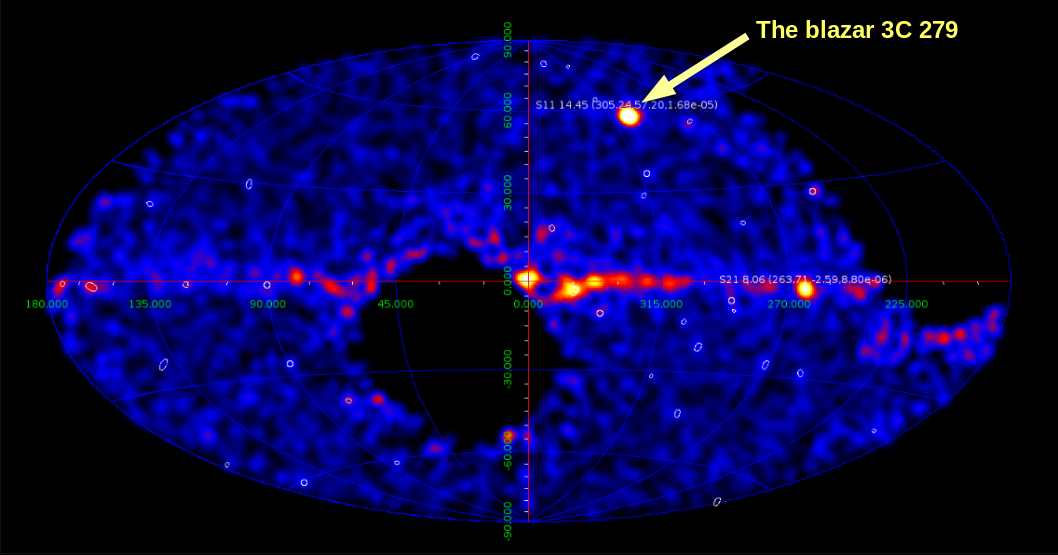
Credits: Screenshot downloaded on January 19, 2018 from the AGILEScience free app dedicated to the AGILE satellite.
|
Dec 30, 2016
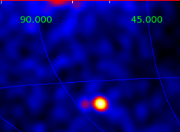 |
50000 orbits of AGILE celebrated with the observation of an exceptional gamma-ray event
A few months before its tenth birthday in orbit, on December 19, 2016 at 06:08:53 UTC the AGILE satellite has reached the significant milestone of 50000 passes over the ASI Malindi Ground Station in Kenya with all detectors operating nominally.
AGILE is devoted to gamma-ray astrophysics, and it is also capable of detecting high energy phenomena of terrestrial nature, such as Terrestrial Gamma-ray Flashes (TGFs) revealed in the Earth equatorial regions. It is also currently at the forefront in the hunt for electromagnetic counterparts of gravitational waves.
The Italian satellite, launched on April 23, 2007 in low Earth orbit, is a small Scientific Mission of ASI, built and operated in cooperation with INAF, INFN, CIFS and with the participation of the Italian companies CGS, Thales-Alenia Space e Telespazio.
The small high-tech jewel, designed for an operative life of only two years, continues its mission with high efficiency, and it has celebrated its 50000 orbit with the observation of an exceptional gamma-ray event of extragalactic origin.
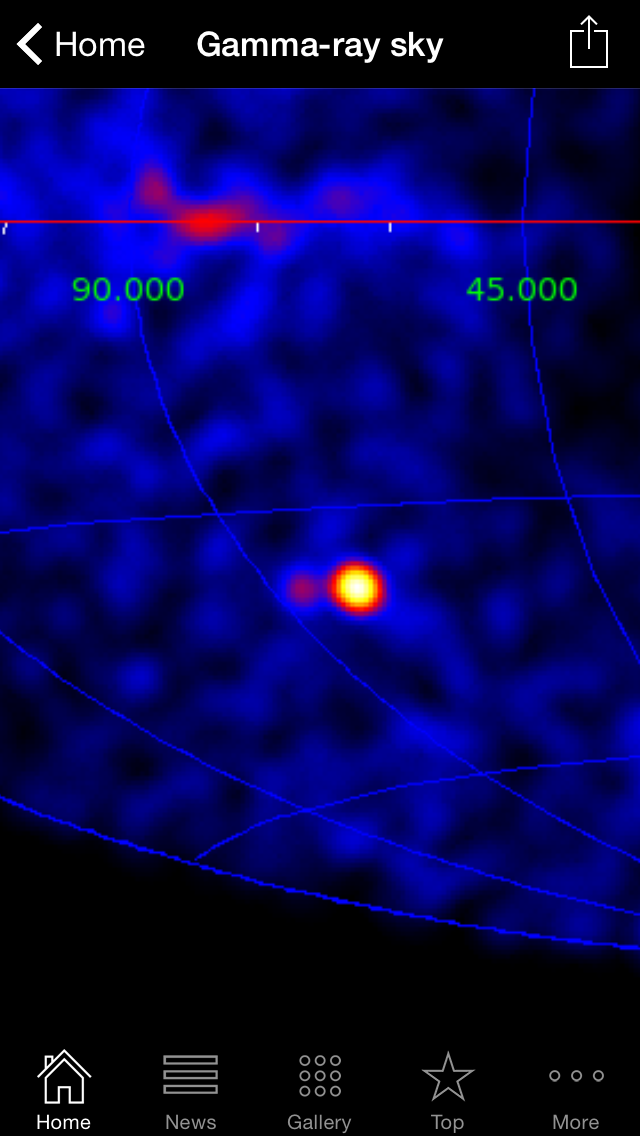
Credits: Screenshot downloaded on December 19, 2016 from the AGILEScience free app dedicated to the AGILE satellite.
As you can see from the fascinating image above, two monsters black holes at the center of the two distant active galactic nuclei CTA 102 and 3C 454.3, apparently close to each other in the AGILE sky map, made a spectacular double super-flare almost simultaneously in gamma rays.
The image was downloaded from the AGILEScience free app that enables anyone to follow in real time the latest satellite observations.
In particular, the CTA 102 source in these days was the brightest of the entire gamma-ray sky, even brighter than much closer sources within our galaxy, such as the Vela pulsar.
For more information, see also:
ASI news and INAF news (in Italian)
AGILE ATel #9743, ATel #9788, ATel #9840, ATel #9911 and references therein.
The AGILE data acquired from the ASI Malindi Ground Station are readily processed archived and managed by the SSDC/ASDC, the multi-mission ASI data center, and distributed to the PI Team alert system at INAF Bologna. The automatic alerts are analyzed daily by researchers of the AGILE team at several INAF institutes and at the ASDC itself.
|
May 29, 2015
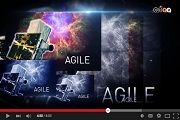 |
AGILE: 8 and counting
"AGILE: 8 and counting", this was the title of the 13th AGILE Workshop celebrating the eighth anniversary of the launch of the AGILE satellite.
Since its launch on 23 April 2007, AGILE has made several important scientific discoveries, such as the variability of the Crab Nebula in gamma-rays, and the existence of a high-energy component in terrestrial gamma-ray flashes (TGF) produced in the Earth atmosphere.
The 13th AGILE Workshop was held in the ASI Headquarters on May 25-26, 2015. The slides of all contributions are publicly available at the workshop website.
A special ASI-TV report by G. Pulcrano was dedicated to AGILE in this occasion. The video (in italian) can be viewed here.
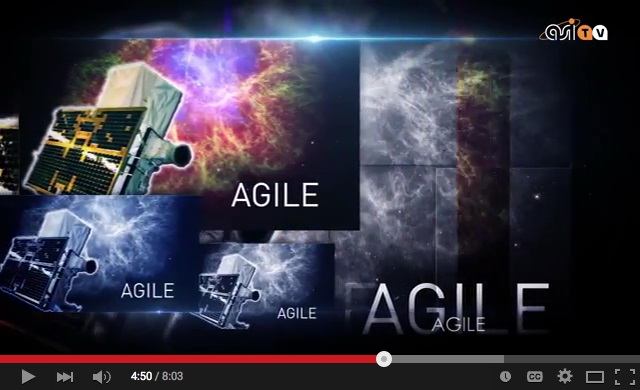
CREDITS: ASI-TV report by Giuseppina Pulcrano, ASI-TV Chief Editor: Manuela Proietti, Video Editor: Daniele Quatrini.
|
Mar 26, 2014
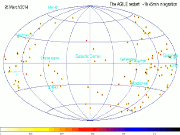 |
AGILE mission operations extended by ASI for another year
After a 3-month 'stand-by' period, during which the AGILE scientific observations were suspended, today the satellite started to look at the gamma-ray sky again. Following the positive evaluation of the scientific results in its first 6 years of operations, and the still nominal status, as evaluated by the AGILE Mission Board, the Italian Space Agency decided to extend the operations of AGILE for additional 12 months.
The animation below shows the first day of data acquisition after the operations restart.
A petition supporting the protraction of the AGILE Mission was started autonomously by a Princeton physicist, Franco Paoletti and by Bruno Coppi, Prof. Emeritus at MIT, working in the area of Plasma Physics. The third signature is the one of the Nobel Prize Russell Hulse, discoverer of the first binary pulsar. Their interest in the AGILE Mission stems from the discovery of the variability of the Crab Nebula in gamma-rays, which earned the 2012 Bruno Rossi Prize to Marco Tavani and the AGILE team. As of today the petition reached almost 500 signatures from all over the world.
A manifestation of interest and a strong support letter was also sent to ASI by the Terrestrial atmospheric science community, interested in the unique contribution that AGILE is giving to the science of Terrestrial Gamma Ray Flashes (TGF).
The first scientific data after the restart has been successfully received and processed today at the AGILE Data Center at ASDC.
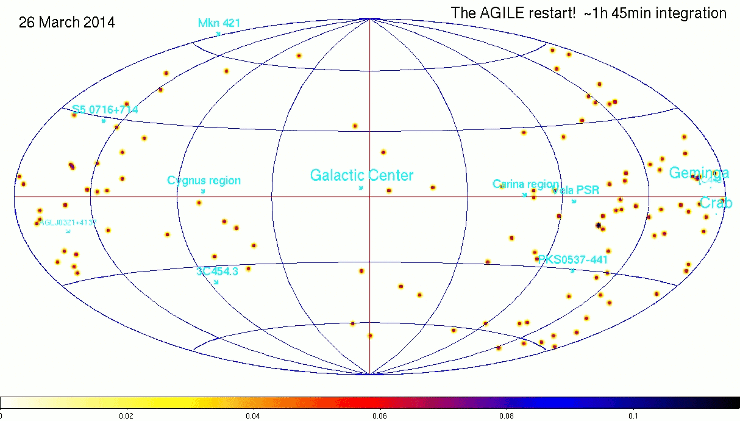
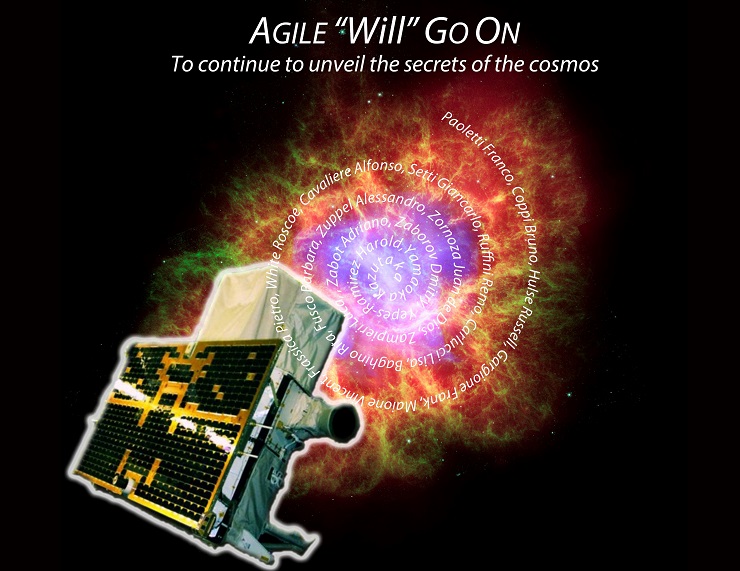
Thank to the hundreds of supporters that signed the petition "AGILE Must Go On". Click here to access the current list of signatures
|
Nov 12, 2013
 |
GRB 131108A in gamma-rays
GRB 131108A, bright but relatively soft in gamma-rays, triggered onboard Fermi-LAT (GCN #15464), and transited in the field of view of AGILE approximately between -20 and +150 seconds from the trigger (t0 = 20:41:55 UT) (GCN #15479). A preliminary reduction of the optical afterglow spectrum indicates a GRB redshift of z=2.40 (GCN #15470).
This is the first onboard Fermi-LAT trigger since 2009, indicating a potentially rare and interesting event. The autonomous repoint of the Fermi spacecraft of 9ksec was followed by a ToO pointed observation until about 23:11 UT of November 9, 2013. The Fermi LAT data flow and quality monitor during this exciting GRB was followed by a duty shifter scientist of ASDC.
A preliminary analysis of the AGILE Gamma-Ray Imaging Detector (GRID) data in temporal and spatial coincidence with the GRB shows a significant excess of gamma-ray events above 30 MeV at the location of the event.
AGILE-GRID detected more than 65 photons compatible with the GRB location in the anticygnus region, most of which below 100 MeV, corresponding to a fluence of 2.56 +- 0.32 1e-5 erg / cm^2 in the energy band 30 MeV - 1 GeV, in which AGILE has a competitive sensitivity.
The AGILE-GRID image of GRB 131108A, one of the most interesting GRB events seen by AGILE after 6 years of observations, is shown in the figure below.
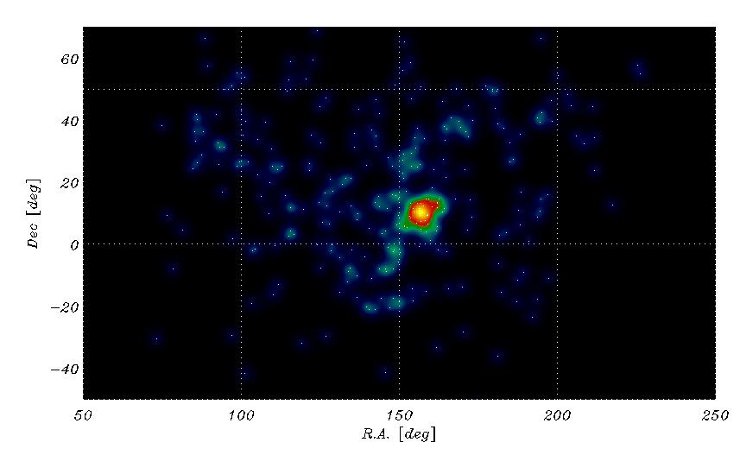
Image: AGILE-GRID view of GRB 131108A , credits AGILE Team.
|
Jan 16, 2013
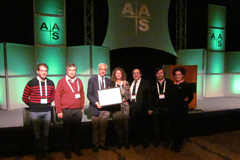 |
Award ceremony of the Bruno Rossi prize 2012 to Marco Tavani and the AGILE Team.
The ceremony for the 2012 "Bruno Rossi" prize, awarded to Marco Tavani and the AGILE Team, was held in Long Beach, CA, on January 10, 2013, during the American Astronomical Society (AAS) 221 Meeting.
The prestigious High Energy Astrophysics Division (HEAD) Rossi prize has been awarded to AGILE for the unexpected discovery in 2010 of strong and rapid gamma-ray flares from the Crab Nebula over daily timescales (M. Tavani et al., Science vol. 331, 2011). Long thought to be a steady source of radiation, from optical to gamma rays, the AGILE findings have changed the understanding of this cosmic object, and challenged emission models of pulsar wind and particle acceleration processes.
The discovery of flaring activity from the Crab nebula was made possible also thanks to the sky monitoring capability and fast ground segment alert system of the AGILE satellite, which also observed a previous flare from the Crab Nebula in October, 2007, reported in the First AGILE source catalog as a possible unexpected brief flux increase (Pittori et al., A&A 506, 2009).
The Rossi Prize lecture: "The Flaring Crab Nebula: Surprises and Challenges" given by Marco Tavani on behalf of the AGILE mission team was among the AAS 221 conference highlights.
See also: AGILE poster presented at the AAS meeting and (in Italian): ASI news, INAF news, INAF-TV Video
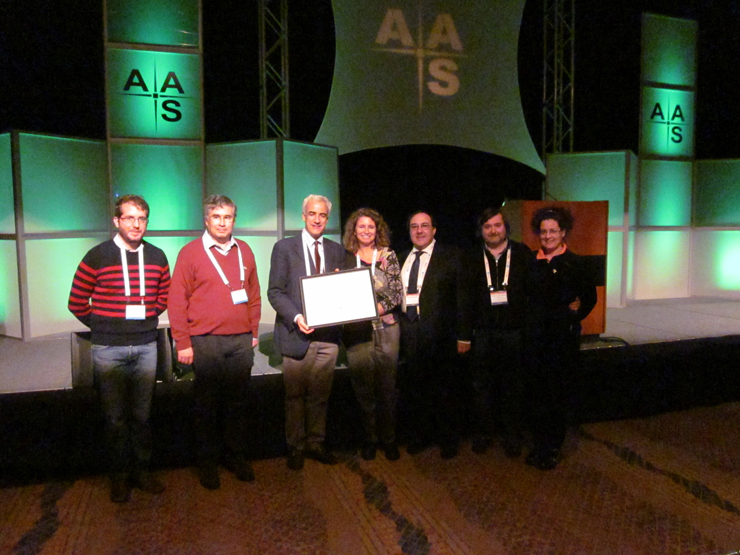
|
January 12, 2012
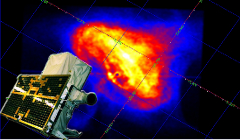 |
AGILE wins the 2012 "Bruno Rossi prize", the fourth time that a mission supported by ASDC is given this important award!
We are proud to announce that the 2012 "Bruno Rossi prize" of the High Energy Astrophysics Division of the American Astronomical Society has been awarded to "Marco Tavani and the AGILE team for the discovery of gamma-ray flares from the Crab Nebula."
AGILE ("Astrorivelatore Gamma a Immagini Leggero") is an Italian space mission dedicated to the observation of the gamma-ray Universe. Despite the small size and budget, AGILE, thanks to its scientific team led by the PI Marco Tavani, produced several important scientific results, among which the discovery of strong flares from the Crab Nebula and the characterization of Terrestrial Gamma-rays Flashes.
This is the fourth time that a space mission in which the ASDC plays an important role has been awarded a "Bruno Rossi prize", after BeppoSAX in 1998, Swift in 2007 and Fermi in 2011.
During 2010 the AGILE discovery of Crab Nebula variability above 100 MeV has astonished the scientific community (M. Tavani et al., Science vol. 331, 2011). Astronomers have always believed the Crab to be a constant source from optical to gamma-ray energies: an ideal standard candle.
However, on September 2010, AGILE detected a giant gamma-ray flare, and thanks to its rapid alert system, made the first public announcement on September 22, 2010. This finding was confirmed the next day by the Fermi Observatory (A. Abdo et al., Science vol. 331, 2011).
A previous flare from the Crab Nebula was observed by AGILE in October, 2007 and reported in the First AGILE source catalog as a possible unexpected flux increase (Pittori et al., A&A 506, 2009).
Funded by ASI, AGILE was built and is operated in cooperation with INAF and INFN, with the participation of CIFS and of several Italian companies: CGS S.p.A, Thales-Alenia Space Italia, Rheinmetall Italia, Telespazio, Galileo Avionica, Mipot.
The satellite was lauched on April 23rd, 2007, from the Indian base of Sriharikota. AGILE raw data are down-linked to the ASI Malindi ground station in Kenya and transmitted first to the Telespazio Mission Control Center at Fucino, and then to the AGILE Data Center.
The AGILE Data Center (ADC), located at ASDC, is in charge of all the scientific oriented activities related to the analysis and archiving of AGILE data.
The AGILE team at ASDC is composed of:
P. Giommi: ASDC responsable and AGILE ASI Project Scientist
C. Pittori: archive scientist, coordinator of the AGILE Data Center
F. Lucarelli: archive scientist
P. Santolamazza: archive scientist
F. Verrecchia: archive scientist
ADC aknowledge the support of all the ASDC staff and infrastucture, and in particular the contribution of A. Antonelli and S. Colafrancesco. ADC aknowledge also the specialist informatic support of G. Fanari, R. Primavera and S. Stellato (Telespazio) and of the late Francesca Tamburelli, who was one of the main architects behind the BeppoSAX, Swift and AGILE data systems.
See also (in Italian): ASI news, INAF news, INFN news, Interview with AGILE PI Marco Tavani.
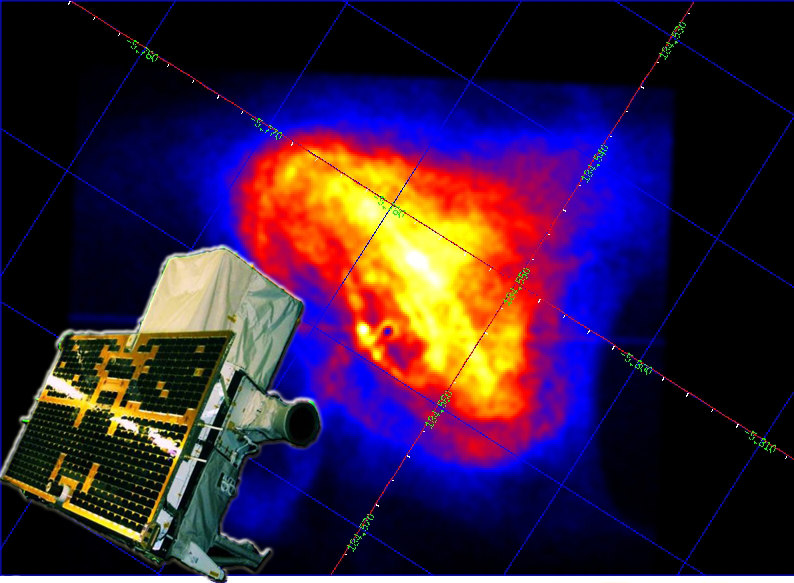
Credits: ASDC. Image background: Chandra X-ray ToO data on September 28, 2010
|
January 5, 2012
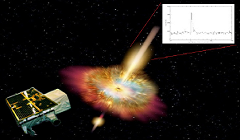 |
GRB 111211A: a new Gamma-ray Burst associated to a Supernova discovered by SuperAGILE
On 11 December 2011 at 22:17:33 UT the SuperAGILE hard X-ray monitor aboard the Italian AGILE satellite localized a Gamma Ray Burst, GRB 111211A (GCN #12666, F. Lazzarotto et al.). The GRB 111211A is the first event discovered by SuperAGILE and associated to a Supernova (GCN #12802, A.de Ugarte Postigo et al.).
While an average number of about 200 - 300 GRBs are localised each year in the X-ray band, less than twenty firm associations with Supernovae are established up to now. The SuperAGILE GRB 111211A is a rare occurrence of a burst which appears to be accompanied by a Supernova explosion, and gives us the opportunity to investigate further the GRB-Supernova connection.
The light-curve of the GRB 111211A prompt emission is composed of two peaks: the first one is hard and also triggered the AGILE Minicalorimeter (MCAL) between 0.3 and 1.4 MeV energy, while the second one is soft and is not detected by CAL above 0.3 MeV, indicating an evident spectral evolution. The AGILE gamma-ray imager (GRID) did not detect a gamma-ray emission from this event above 50 MeV energy. The burst prompt emission has a remarkable time-integrated fluence, 9.2 x 10-6erg/cm2, as measured in the 20 - 1200 keV energy range by the Konus-Wind instrument (GCN #12676, S. Golenetskii et al.).
A Target of Opportunity observation by the Swift satellite was performed, and the afterglow was rapidly localised in X-rays (GCN #12673) and in optical-UV (GCN #12678) at a position within the SuperAGILE error region.
In the follow-up campaign the redshift of GRB 111211A was measured at z=0.478 with the X-shooter spectrograph mounted on the ESO-VLT telescope (GCN #12677). Telescopes as GROND (GCN #12668), NOT (GCN #12675) and Mt. Terskol (GCN #12704) were involved in the follow-up campaign to study the decay law of the afterglow.
On 1 January 2012, about 20 days after the SuperAGILE detection, the optical afterglow was still at a magnitude of r ~ 22.6, as observed by the GTC telescope at the Roque de los Muchachos Observatory (La Palma, Spain). The almost flat evolution at late-time of the lightcurve of the optical afterglow indicates a possible Supernova component contribution (GCN #12802). In the same observation, the spectrum of the afterglow shows characteristic signatures of a Supernova, similar to the spectrum of the type Ic SN 2006aj / GRB 060218 close to the maximum.
GRBs can be classified depending on their duration and on the boundary between short and long events is fixed at 2 s. A fairly low number of long GRBs are associated with core-collapse Supernovae, whose emission starts to show up in the lightcurve of the optical afterglow few weeks after the prompt emission. The first of these associations was discovered in 1998 by the Italian satellite BeppoSAX, between GRB 980425 and SN 1998bw.
Characteristic of the Supernovae associated to GRBs is the highly relativistic speed of their ejecta. The explanation of the so called "GRB Supernova connection" involves the explosion of massive and highly rotating stars that have lost their hydrogen envelope. The relationship, however, is not yet fully understood since there are some nearby long GRBs for which the association with a Supernova has not been found.
GRBs associated to Supernovae are generally concentrated at low redshift (that is at small distance from us), while GRB 111211A is in the higher redshift tail of the distribution. The "central engine" at the origin of the GRBs emission is still unknown and the possible correlation with other types of cosmic explosions, for example Supernovae, can give new information to understand these fascinating and still enigmatic transients.
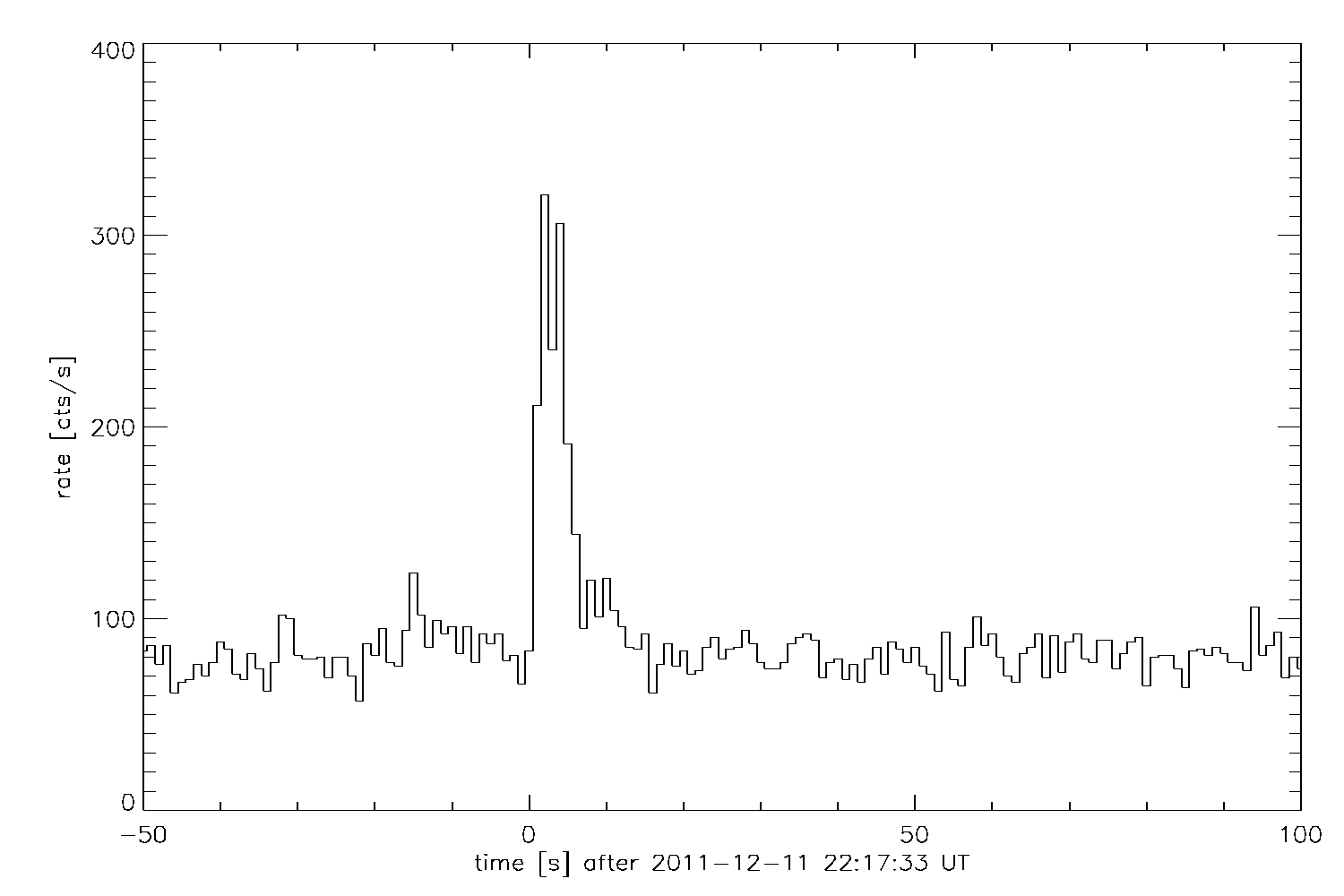
Lightcurve of the SuperAGILE GRB 111211A
|
November 24, 2011
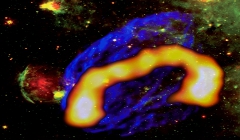 |
AGILE sheds light on the mistery of the origin of comic rays
AGILE has discovered a pattern of gamma-ray emission from the supernova remnant W44 that, combined with the observed multifrequency properties of the source, can be unambiguously attributed to accelerated protons interacting with nearby dense gas.
The AGILE gamma-ray imager reaches its optimal sensitivity just at the energies in the 50 MeV-a few GeV range at which neutral pions (produced by proton-proton interactions) radiate with an unambiguous signature.
The AGILE data resolves the problem of clearly identifying a source of energetic cosmic rays in our Galaxy exactly 100 years after the discovery of cosmic rays by Victor Hess in 1912. Up to now a direct identification of sites in our Galaxy where proton acceleration takes place was elusive. This important AGILE result is reported in a paper to be published by Astrophysical Journal Letters (A. Giuliani et al., 2011).
All the scientific oriented activities related to the analysis, archiving and distribution of AGILE data are supported by the AGILE Data Center at ASDC.
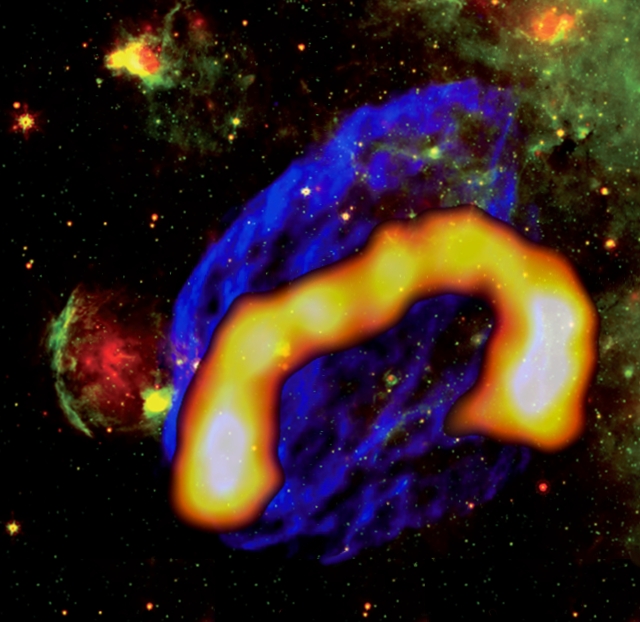
Figure credits: AGILE Team, G. Castelletti, G. Dubner
|
April 19, 2011
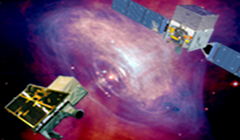 |
New Crab Nebula enhanced activity and unprecedented giant flare in gamma-rays
A renewed increase of the gamma-ray activity above 100 MeV from the Crab Nebula has been recently reported by Fermi in ATel #3276 (R. Buheler at al.) in the period April 9-11, 2011, and confirmed by the AGILE monitoring in ATel #3282 (M. Tavani et al.).
We recall that a gamma-ray flux increase from the direction of the Crab Nebula was reported for the first time by AGILE, and then confirmed by Fermi in September 2010 (ATel #2855 and ATel #2861).
Fermi satellite began a pointed mode observation of the Crab Nebula in response to the recent observed increase in gamma-ray activity.
A ToO Swift/XRT observation was also promptly performed but no significant X-ray flux variation was detected, as reported in ATel #3279 (G. Cusumano et al.).
Chandra was observing the Crab on April 12 and 13, 2011 as part of their monitoring program, which began following the previous surprising gamma-ray flare in September 2010. Chandra observations are reported in ATel #3283 (A. Tennant et al.).
A very strong gamma-ray flare was then detected by AGILE on April 16, 2011, see ATel #3286 (E. Striani et al.). The flux above 100 MeV reached the unprecedented value of F = (20.0 ± 3.7) 10^{-6} ph/cm2/sec. The detected gamma-ray flux from the Crab was then twice as bright as the Vela Pulsar.
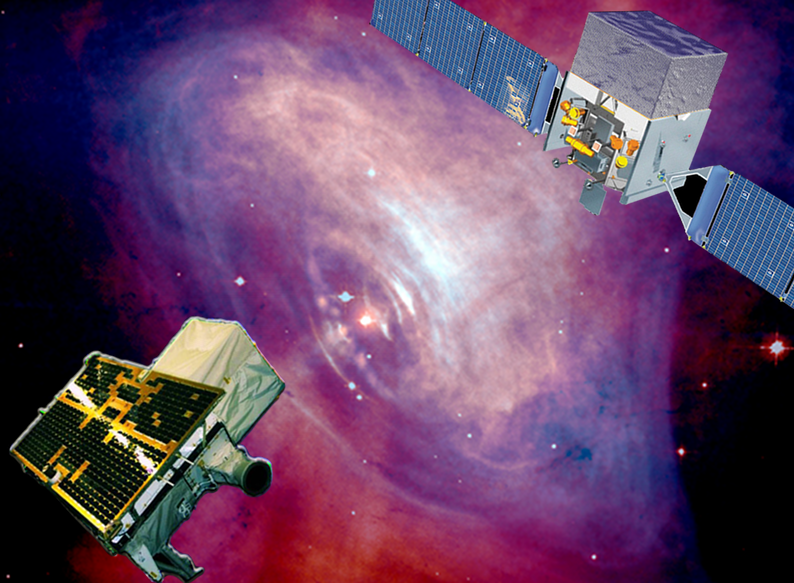
Credits: Image background X-ray: NASA/CXC/ASU/J.Hester et al.; Optical: NASA/HST/ASU/J.Hester et al., AGILE (ASI) and Fermi (NASA) satellites.
|
October 7, 2010
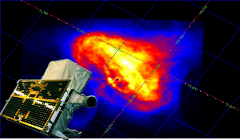 |
The Crab "goes wild" in gamma-rays
More suprises from sky observations in gamma-rays.
The ASI satellite AGILE, thanks to its sky monitoring capability and fast ground segment alert system, has discovered an increased gamma-ray flux above 100 MeV from a source positionally consistent with the Crab Nebula.
The unexpected discovery has been promptly reported on September 23, 2010 in ATel #2855 (M. Tavani et al.), and confirmed the next day by the Fermi satellite in ATel #2861 (R. Buehler et al.). Fermi interrupted its all-sky scanning mode and completed a dedicated pointed observation of the Crab Nebula from 2010-09-23 to 2010-09-27 to increase its exposure on the source. Measurements taken starting on 23 September show that the gamma-ray flux is back to normal values, see ATel #2879.
The Crab Pulsar and Nebula are the remnants of the explosion of the supernova SN1054, and the spectra containing the diffuse and pulsed emission has always been considered the standard X-ray candle for X-ray and gamma-ray satellites used also for instrument calibration.
Following the surprising discovery by AGILE, the results of INTEGRAL observations of the Crab nebula, performed for calibration purpose, and the Swift/BAT team routine monitor of the source were reported in ATel #2856 and ATel #2858 respectively. In these hard X-rays observations, however, no statistically significant increase in the Crab flux was observed.
Special ToO observations were then requested and performed by Swift, see ATel #2866, Chandra, see ATel #2882, and Hubble Space Telescope, see ATel #2903. Comparing the current Crab Nebula image with the extensive database available in the HST public archive, an increased emission about 3 arcsec East of the pulsar was noticed. The Chandra exposure, taken a few days before the HST one, reported a brightening from the same region.
Gamma-ray data suggests that the origin of the flare is related to the nebula rather than the pulsar emission, and provide evidence for particle acceleration mechanisms in nebular shock regions more efficient than previously expected from current theoretical models.
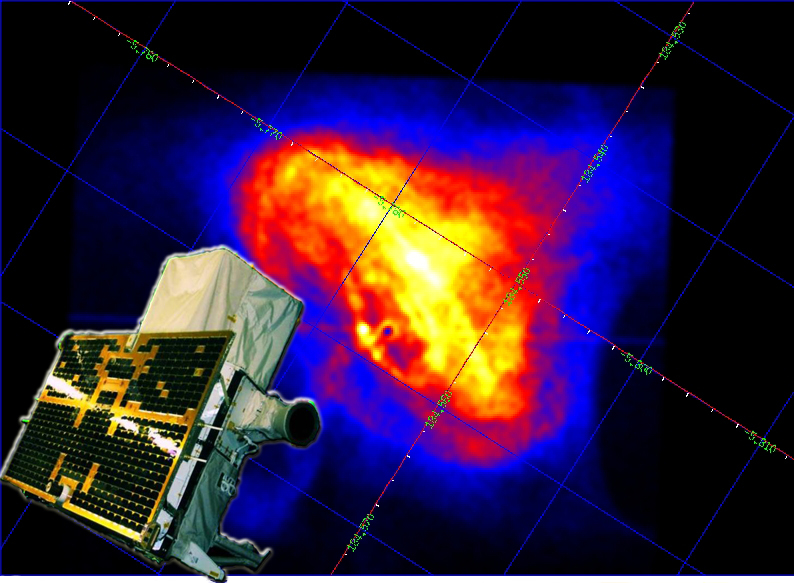
In the image background: Chandra X-ray Observatory data from the ToO observation of Crab on September 28, 2010, following the gamma-ray flare detected by AGILE.
|
July 26, 2010
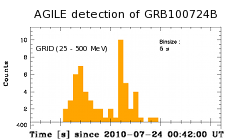 |
AGILE-GRID detects its brightest Gamma-Ray Burst
On July 24, 2010 AGILE detected the long bright GRB100724B (Bhat et al., GCN #10977) with both MCAL and GRID instruments (Marisaldi et al., GCN #10994, Giuliani et al., GCN #10996).
The gamma-ray emission observed by the AGILE-GRID instrument in the energy range 25 - 500 MeV with high statistical significance lasted about 100 seconds. Two main peaks are evident in the lightcurves of both low and medium-high energy gamma-rays, as also observed by Fermi LAT (see Tanaka et al., GCN #10978).
GRB 100724B turns out to be the brightest GRB detected by AGILE-GRID during its operations in space and one of the brightest ever detected above ~25 MeV.
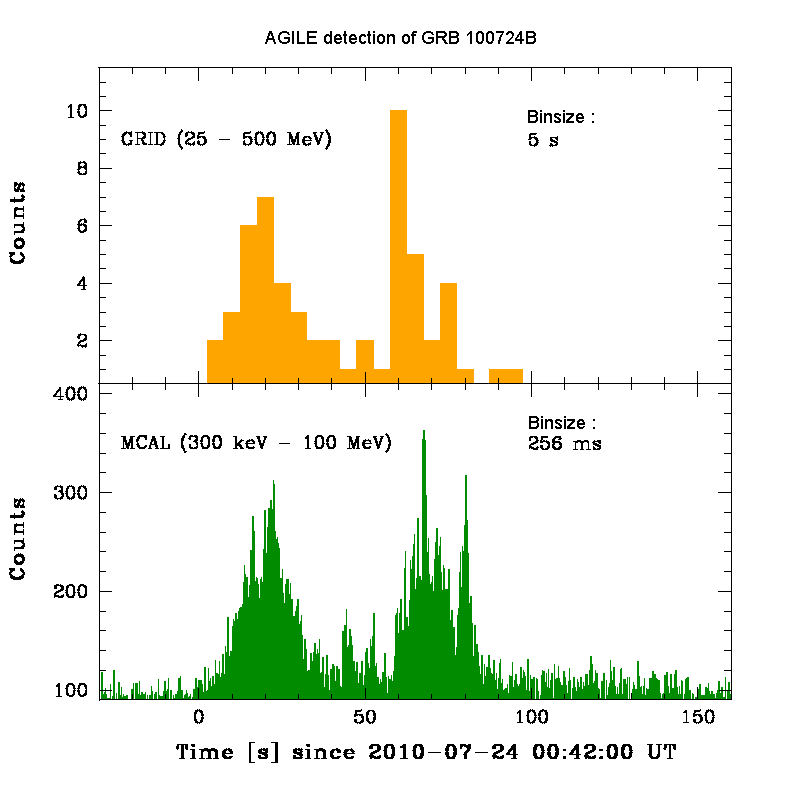
|
February 15, 2010
 |
The AGILE satellite detects "super-energetic TGFs" that could affect air travel
"Terrestrial Gamma-Ray Flashes" (TGF) are phenomena of terrestrial (atmospheric) origin only lasting a few milliseconds that are likely associated to very intense tropical thunderstorms. The AGILE satellites detected several of these events since its first months of operations.
The AGILE equatorial orbit, together with its advanced payload capabilities, allowed the discovery of TGFs with gamma-ray energy reaching up to 50 MeV.
Such highly energetic radiation must be produced in atmospheric conditions requiring potential differences of 100 Mega Volts or more, hundreds of times larger than that required to produce the usual terrestrial lightning.
As announced in a joint press release that can be found on the ASI and INAF websites, the AGILE Team and ASI are collaborating with ENAC (Ente Nazionale per l'Aviazione Civile) to understand the possible hazards to air traffic that these very energetic atmospheric events might cause.
THE AGILE paper "Detection of Terrestrial Gamma-Ray Flashes up to 40 MeV by the AGILE satellite" by M. Marisaldi et al. (2009), previously announced on this website on October 29th 2009, is now being published in the Journal of Geophysical research and it is accessible on-line at:
https://www.ssdc.asi.it/news/Marisaldi2009_AGILE-TGF.pdf
|
November 12, 2009
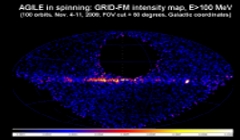 |
AGILE science operations resumed on November 4th, 2009
On November 4, 2009 at 12:25:54 the AGILE scientific operations restarted. The instrument is operating nominally, and all detectors are on and acquiring data. The satellite is currently in a safe spinning mode, with the fixed solar panels pointing towards the Sun and the GRID instrument FOV covering a good fraction of the whole sky.
In the figure below we show a preliminary 100-orbit gamma-ray intensity map above 100 MeV in the spinning configuration.
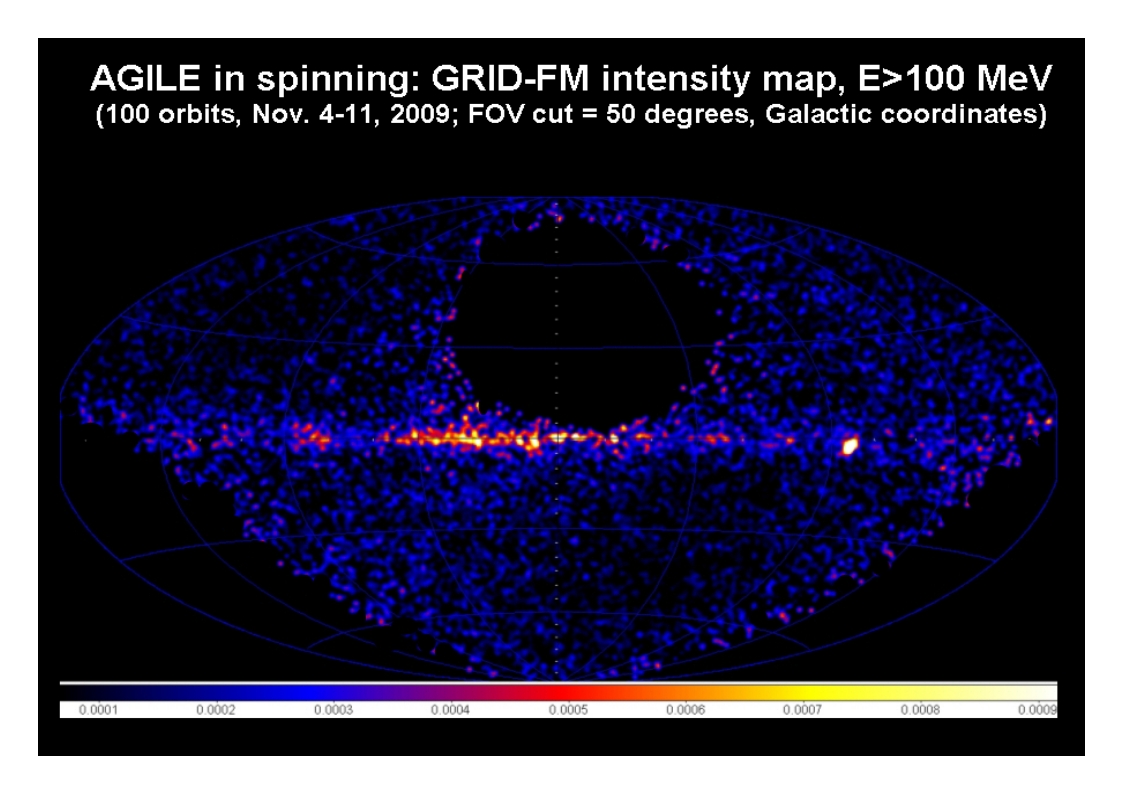
|
April 21, 2009
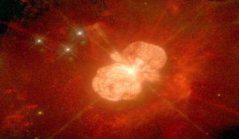 |
AGILE Detection of Gamma-ray Emission from the Eta-Carinae Region
AGILE Detection of Gamma-ray Emission from the Eta-Carinae Region M. Tavani et al., ApJ 698 No 2 (2009 June 20) L142-L146
During the period 2007 July - 2009 January, AGILE detected a gamma-ray source (1AGL J1043-5931) consistent with the position of the colliding wind binary system Eta-Car.
A 2-day gamma-ray flaring episode of the source was also reported on 2008 Oct. 11-13, possibly related to a transient acceleration and radiation episode of the strongly variable shock in the system.
If 1AGL J1043-5931 is the eta-Car gamma-ray counterpart, AGILE data show the first remarkable detection of a colliding wind binary system (CWB) at hundreds of MeV energies, confirming the efficient particle acceleration and the highly non-thermal nature of the strong shock in such system.
|
|



